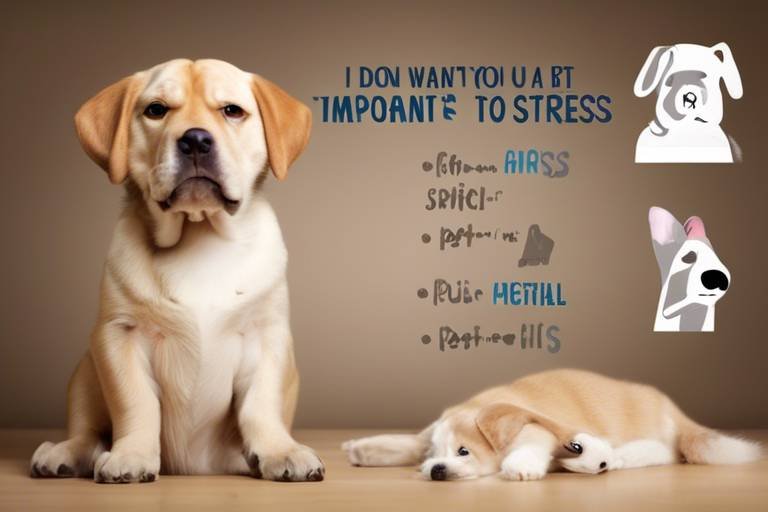How to Help Your Pet Cope with Separation Anxiety
Separation anxiety in pets can be a heart-wrenching experience for both the animal and its owner. Imagine coming home after a long day, only to find your furry friend distressed and anxious, longing for your presence. It's a scenario many pet owners face, and it can lead to a cycle of worry and frustration. But fear not! There are effective strategies and techniques to help your beloved pet cope with this emotional turmoil. In this article, we will explore various methods to alleviate separation anxiety, ensuring your pet's well-being and comfort when left alone. From understanding the underlying issues to implementing practical solutions, we’ve got you covered!
So, what exactly is separation anxiety? It’s a common behavioral issue in pets, particularly dogs, characterized by excessive distress when their owner leaves them alone. This anxiety can stem from various factors, including past trauma, changes in routine, or even a lack of socialization. Understanding the root cause of your pet's anxiety is crucial in providing the right support. Recognizing its symptoms is the first step in ensuring your furry friend feels safe and secure, even when you're not around.
Identifying the signs of separation anxiety is crucial for any pet owner. These symptoms can manifest in various ways, and being aware of them can help you take appropriate action to ease your pet's distress. Common symptoms include:
- Excessive barking or whining: This vocalization is often a cry for help, signaling that your pet is struggling to cope with being alone.
- Destructive behavior: Chewing furniture, scratching doors, or digging can all be signs of an anxious pet expressing their frustration.
- House soiling: Accidents in the house can occur when pets feel overwhelmed and unable to control their anxiety.
- Physical symptoms: Look out for excessive drooling, pacing, or trembling, which can indicate discomfort during separation.
Behavioral signs of separation anxiety can vary widely among pets. Observing your pet's reactions when you leave can provide valuable insights into their emotional state. For instance, some pets may become clingy, following you around the house, while others might hide away, indicating their distress. By paying close attention to these behaviors, you can tailor your response to meet your pet's specific needs.
Excessive barking or whining is a significant indicator of separation anxiety. This vocalization is often a cry for help, signaling that your pet is struggling to cope with being alone. If you notice this behavior, it’s essential to address it promptly to prevent it from becoming a habit.
Destructive behaviors, such as chewing furniture or scratching doors, are common in anxious pets. These actions may be their way of expressing distress and frustration when left alone. It's like they’re trying to tell you, “I can’t handle this!” Addressing these behaviors early on can help prevent further damage and discomfort for your pet.
In addition to behavioral signs, pets may exhibit physical symptoms of anxiety. These can include excessive drooling, pacing, or even trembling, indicating their discomfort during separation. Recognizing these signs is vital in understanding the severity of your pet's anxiety and determining the best course of action.
Training plays a vital role in managing separation anxiety. Implementing gradual desensitization and positive reinforcement can help pets feel more secure when left alone, ultimately reducing their anxiety levels. Think of it as building your pet's confidence step by step, much like teaching a child to ride a bike. You wouldn't just push them off and hope for the best, right?
Gradual desensitization involves slowly acclimating your pet to being alone. Start with short departures and gradually increase the duration. This process helps your pet build confidence and reduces anxiety over time. For example, you might begin by leaving your pet alone for just five minutes, then gradually extend that time to 10, 20, and eventually longer periods.
Using positive reinforcement techniques, such as treats and praise for calm behavior, can encourage your pet to associate your departures with something positive. This method not only eases their anxiety but also strengthens the bond between you and your furry friend. Remember, every small victory counts!
Establishing a comfortable and secure environment for your pet can significantly reduce anxiety. A designated safe space allows them to feel secure when you leave, helping to ease their distress. Think of it as their personal sanctuary, a place where they can retreat and relax.
Selecting an appropriate location for your pet's safe space is essential. Consider a quiet area with familiar items, such as their bed or favorite toys, to create a calming atmosphere. This space should be free from distractions and loud noises, allowing your pet to unwind and feel at ease.
Incorporating comfort items, like blankets or clothing with your scent, can provide reassurance to your pet. These familiar scents can help soothe them during your absence, reducing feelings of anxiety. It's like leaving a piece of you behind, reminding them that you’ll return.
If your pet's separation anxiety is severe, seeking professional help may be necessary. Veterinarians or animal behaviorists can provide tailored advice and treatment options to support your pet's emotional well-being. Sometimes, having an expert in your corner can make all the difference.
Behavioral therapies offered by professionals can address the root causes of separation anxiety. Techniques may include structured training sessions and tailored behavioral modification plans to help your pet cope more effectively. These strategies can provide a roadmap for you and your pet, guiding you both toward a more comfortable separation experience.
In some cases, medication may be recommended to manage severe anxiety. Consulting with a veterinarian can help determine if this approach is appropriate for your pet's specific needs and circumstances. Remember, medication is not a one-size-fits-all solution, and it’s essential to consider it as part of a comprehensive treatment plan.
Q: Can all pets experience separation anxiety?
A: Yes, while it’s more common in dogs, cats and other animals can also experience separation anxiety.
Q: How long does it take to see improvement?
A: Improvement can vary based on the pet and the techniques used. Consistency is key, and you may see changes within a few weeks to a few months.
Q: Should I get another pet to help with separation anxiety?
A: While having another pet might help some animals feel less lonely, it’s not a guaranteed solution and can sometimes lead to more anxiety.
Q: When should I seek professional help?
A: If your pet’s anxiety is severe, persistent, or leads to destructive behavior, it’s wise to consult a veterinarian or animal behaviorist.

Understanding Separation Anxiety
Separation anxiety is a common issue that affects many pets, particularly dogs and cats. It occurs when they experience extreme distress or fear when their owners leave them alone. Imagine being in a room full of people, yet feeling utterly isolated when your best friend steps out – that’s how your furry companion feels when you leave. This emotional turmoil can lead to various behavioral problems, making it crucial for pet owners to recognize and understand this condition.
To effectively address separation anxiety, it’s essential to first recognize its underlying causes. Pets are social animals, and their attachment to their owners can lead to intense feelings of insecurity when left alone. Factors contributing to separation anxiety may include:
- A change in routine, such as a new job or moving to a new home
- Loss of a family member or another pet
- Previous traumatic experiences, such as abandonment or being in a shelter
- Lack of proper training or socialization
Understanding these factors can help you empathize with your pet’s feelings and provide the necessary support. It’s also important to note that separation anxiety can manifest in various ways. Some pets may vocalize their distress through excessive barking or whining, while others might resort to destructive behaviors, such as chewing furniture or scratching at doors. Recognizing these signs is the first step in helping your pet feel more comfortable when left alone.
Furthermore, pets may exhibit physical symptoms of anxiety, including:
- Excessive drooling
- Pacing back and forth
- Trembling or shaking
Each pet is unique, and their reactions to separation can vary widely. By paying close attention to your pet’s behavior and emotional state, you can tailor your approach to meet their specific needs. This understanding will not only help you address their anxiety but also strengthen the bond between you and your furry friend.
In summary, understanding separation anxiety is the key to providing the right support for your pet. By recognizing the symptoms, identifying potential triggers, and being empathetic to their feelings, you can create a nurturing environment that fosters their emotional well-being.

Common Symptoms to Watch For
Identifying the signs of separation anxiety in pets is crucial for their well-being. When our furry friends experience distress upon our departure, they may exhibit a range of behaviors that can be alarming for pet owners. Recognizing these symptoms early on can help you take appropriate action to alleviate their anxiety. Common symptoms include excessive barking, destructive behavior, and even house soiling. These behaviors are not just annoying; they are your pet's way of communicating their discomfort and fear.
It's essential to observe your pet's reactions closely when you prepare to leave. For instance, do they follow you around the house, or do they seem unusually clingy? Such behaviors can be indicative of their anxiety levels. In many cases, pets may display a combination of both behavioral and physical symptoms, making it even more critical to understand the signs. Let's delve deeper into these symptoms:
Behavioral signs can vary significantly among pets, and understanding these can provide valuable insights into their emotional state. For example, if your dog starts barking excessively as soon as you grab your keys, it could be a clear indication of their anxiety. Similarly, some pets may engage in destructive behaviors, such as chewing on furniture or scratching at doors. These actions are often not just playful antics; they are expressions of their distress and frustration when left alone.
One of the most noticeable signs of separation anxiety is excessive vocalization. If your pet barks or whines incessantly when you leave, it’s their way of signaling that they are struggling to cope with being alone. This vocalization can escalate to the point where it becomes a nuisance, not only for you but also for your neighbors. It's important to remember that this behavior is a cry for help, and addressing it promptly can make a significant difference.
Destructive behaviors are another common manifestation of separation anxiety. Pets may chew on furniture, dig at carpets, or scratch doors in an attempt to escape their confinement. These actions can lead to costly repairs and may even pose a danger to your pet if they ingest harmful materials. Understanding that these behaviors stem from anxiety can help you approach the situation with empathy and seek solutions that address the root cause.
In addition to behavioral signs, pets may exhibit physical symptoms of anxiety. These can include excessive drooling, pacing, or even trembling. Such physical manifestations indicate that your pet is genuinely uncomfortable during your absence. For instance, if you notice your dog pacing back and forth or trembling when you leave, it’s a strong sign that they are feeling stressed. Recognizing these physical symptoms is vital, as they can help you gauge the severity of your pet's anxiety and inform your approach to managing it.
In summary, being aware of the common symptoms of separation anxiety is the first step in providing effective support for your beloved animal companion. By understanding the behavioral and physical signs, you can take proactive measures to alleviate their distress and ensure their emotional well-being.
- What should I do if my pet shows signs of separation anxiety? It's best to start by observing their behaviors and consulting with a veterinarian or animal behaviorist for tailored advice.
- Can separation anxiety be cured? While it may take time and effort, many pets can learn to cope better with separation through training and behavioral modification.
- Are certain breeds more prone to separation anxiety? Yes, some breeds are more susceptible to separation anxiety, including Labrador Retrievers, German Shepherds, and Cavalier King Charles Spaniels.
- Is medication an option for pets with severe separation anxiety? Yes, in some cases, veterinarians may prescribe medication to help manage severe anxiety, but this should be discussed on a case-by-case basis.
Behavioral Signs
When it comes to understanding your pet's emotional state, are your best clue. Pets, much like humans, express their feelings through actions. If your furry friend is struggling with separation anxiety, you might notice a range of behaviors that signal their distress. For instance, when you prepare to leave, does your dog start to pace or hide? Or does your cat suddenly become clingy, following you from room to room? These actions can be indicative of underlying anxiety.
One of the most alarming behavioral signs is excessive vocalization. This can manifest as barking, whining, or even howling. If your pet seems to turn into a mini alarm system the moment you step out the door, it’s a clear indication that they are not handling the separation well. Think of it this way: if you were left alone in a crowded room and no one acknowledged your presence, wouldn't you shout for attention too?
Another common behavior is destructive actions. This might include chewing on furniture, scratching at doors, or even digging at the carpet. While it may seem like your pet is just being naughty, these actions are often cries for help. They may be trying to escape their feelings of loneliness or frustration. It's important to recognize that these behaviors stem from anxiety, not just a lack of training or discipline.
Additionally, you might observe signs of restlessness. Your pet may pace back and forth or seem unable to settle down. This constant movement is their way of coping with the stress of being alone. Just like a person who can't sit still when anxious, your pet is expressing their discomfort through movement.
It’s also crucial to pay attention to how your pet behaves when you return home. Do they greet you with overwhelming excitement, or do they seem indifferent? A pet that is overly excited may be trying to compensate for their time alone, while indifference can be a sign of resignation to their situation. Understanding these nuances can help you tailor your approach to easing their anxiety.
In summary, recognizing these behavioral signs is the first step in addressing your pet's separation anxiety. By being observant and responsive to their needs, you can create a more comfortable and supportive environment for them. Remember, your attention and understanding can make all the difference in their emotional well-being.
- What should I do if my pet shows signs of separation anxiety?
Start by observing their behavior and implementing gradual desensitization techniques. Consider creating a safe space for them and consulting with a veterinarian if needed. - Can separation anxiety be cured?
While it may not be entirely curable, many pets can learn to manage their anxiety with proper training and support. - How long does it take to see improvements?
The time frame can vary based on the individual pet and the consistency of the techniques used, but with patience, improvements can often be seen within weeks.
Vocalization Issues
This article explores effective strategies and techniques to alleviate separation anxiety in pets, ensuring their well-being and comfort when left alone. Discover insights and tips to support your furry friends.
Separation anxiety is a common issue in pets, characterized by distress when their owner leaves. Recognizing its symptoms is the first step in providing effective support for your beloved animal companion.
Identifying the signs of separation anxiety is crucial. Common symptoms include excessive barking, destructive behavior, and house soiling. Understanding these behaviors can help pet owners take appropriate action to ease their pet's distress.
Behavioral signs of separation anxiety can vary widely among pets. Observing your pet's reactions when you leave can provide valuable insights into their emotional state and help tailor a response to their needs.
Excessive barking or whining is a significant indicator of separation anxiety. This vocalization is often a cry for help, signaling that your pet is struggling to cope with being alone. Imagine your pet, pacing around the room, their ears perked up, waiting for the sound of your footsteps. When they realize you're not coming back right away, they may express their distress through vocalizations that can be quite alarming for both the pet and the owner.
It's important to note that each pet may vocalize differently. For some, it might be a series of high-pitched barks, while others may opt for a more mournful howl. These sounds can escalate, leading to a cycle of anxiety and noise that can disturb neighbors and create additional stress for the pet. The emotional toll on both the pet and owner can be significant, making it essential to address these vocalization issues promptly.
To help manage these vocalizations, consider the following strategies:
- Desensitization: Gradually get your pet accustomed to being alone for short periods, slowly increasing the duration over time.
- Engagement: Provide interactive toys or puzzles that can keep your pet occupied and distracted while you're away.
- Calming Aids: Explore calming collars or sprays that may help soothe your pet during your absence.
By addressing vocalization issues head-on, you can pave the way for a more peaceful environment for both you and your pet. Remember, the goal is to help your furry friend feel secure and comforted, even when you're not around.
Training plays a vital role in managing separation anxiety. Implementing gradual desensitization and positive reinforcement can help pets feel more secure when left alone, ultimately reducing their anxiety levels.
Gradual desensitization involves slowly acclimating your pet to being alone. By starting with short departures and gradually increasing the duration, you can help your pet build confidence and reduce anxiety.
Using positive reinforcement techniques, such as treats and praise for calm behavior, can encourage your pet to associate your departures with something positive, thus alleviating their anxiety over time.
Establishing a comfortable and secure environment for your pet can significantly reduce anxiety. A designated safe space allows them to feel secure when you leave, helping to ease their distress.
Selecting an appropriate location for your pet's safe space is essential. Consider a quiet area with familiar items, such as their bed or favorite toys, to create a calming atmosphere.
Incorporating comfort items, like blankets or clothing with your scent, can provide reassurance to your pet. These familiar scents can help soothe them during your absence, reducing feelings of anxiety.
If your pet's separation anxiety is severe, seeking professional help may be necessary. Veterinarians or animal behaviorists can provide tailored advice and treatment options to support your pet's emotional well-being.
Behavioral therapies offered by professionals can address the root causes of separation anxiety. Techniques may include structured training sessions and tailored behavioral modification plans to help your pet cope more effectively.
In some cases, medication may be recommended to manage severe anxiety. Consulting with a veterinarian can help determine if this approach is appropriate for your pet's specific needs and circumstances.
- What is separation anxiety in pets?
Separation anxiety is a condition where pets experience extreme distress when separated from their owners, often leading to destructive behavior or excessive vocalization.
- How can I tell if my pet has separation anxiety?
Common signs include excessive barking, destructive behavior, house soiling, and physical symptoms like drooling or pacing.
- What are some quick fixes for separation anxiety?
While there are no instant solutions, gradual desensitization, providing comfort items, and keeping your pet engaged can help alleviate symptoms.
- When should I seek professional help?
If your pet's anxiety is severe and persistent, or if home strategies aren't effective, it's advisable to consult a veterinarian or animal behaviorist.
Destructive Behavior
Destructive behavior in pets is often a clear indication of their separation anxiety. When your furry friend feels anxious about being left alone, they may resort to actions that can be quite damaging, not only to your home but also to their own well-being. This behavior can manifest in various ways, such as chewing on furniture, scratching at doors, or even digging at carpets. It's almost as if they are trying to express their discomfort and frustration through these actions. Imagine being left in a room filled with reminders of your loneliness, and the only way to cope is to act out. That’s what your pet might be feeling.
Understanding the underlying reasons for this destructive behavior is crucial. For many pets, their home represents a safe haven, and when they perceive a threat—like the absence of their owner—their instinct may drive them to respond with chaos. This can lead to a vicious cycle where the pet becomes even more anxious, leading to more destructive actions. It’s essential to recognize that these behaviors are not just acts of rebellion; they are cries for help.
To effectively manage and reduce these destructive tendencies, consider implementing the following strategies:
- Provide Plenty of Exercise: A tired pet is generally a calm pet. Regular exercise can help expend excess energy and reduce anxiety levels.
- Interactive Toys: Keeping your pet engaged with puzzle toys or treat-dispensing toys can distract them and keep their minds occupied while you’re away.
- Safe Spaces: Create a designated area where your pet can feel secure and comfortable, perhaps with their favorite toys and bedding.
By addressing the root causes of destructive behavior, you can help your pet learn to cope with being alone. It’s essential to be patient and consistent in your approach, as breaking these habits won't happen overnight. Remember, your pet relies on you to help them navigate their feelings of anxiety, and with the right strategies in place, you can foster a more peaceful environment for both of you.
- What are the first signs of separation anxiety in pets? Look for excessive barking, destructive behavior, and signs of distress when you prepare to leave.
- Can separation anxiety be cured? While it may not be completely "cured," it can be effectively managed with training and support.
- How long does it take to see improvement? Each pet is different, but with consistent effort, you may start to see improvements within a few weeks.
Physical Symptoms
This article explores effective strategies and techniques to alleviate separation anxiety in pets, ensuring their well-being and comfort when left alone. Discover insights and tips to support your furry friends.
Separation anxiety is a common issue in pets, characterized by distress when their owner leaves. Recognizing its symptoms is the first step in providing effective support for your beloved animal companion.
Identifying the signs of separation anxiety is crucial. Common symptoms include excessive barking, destructive behavior, and house soiling. Understanding these behaviors can help pet owners take appropriate action to ease their pet's distress.
Behavioral signs of separation anxiety can vary widely among pets. Observing your pet's reactions when you leave can provide valuable insights into their emotional state and help tailor a response to their needs.
Excessive barking or whining is a significant indicator of separation anxiety. This vocalization is often a cry for help, signaling that your pet is struggling to cope with being alone.
Destructive behaviors, such as chewing furniture or scratching doors, are common in anxious pets. These actions may be their way of expressing distress and frustration when left alone.
In addition to behavioral signs, pets may exhibit physical symptoms of anxiety. These can include excessive drooling, pacing, or even trembling, indicating their discomfort during separation. Just like humans, pets can manifest their anxiety through physical reactions, and being aware of these signs can help you intervene early. For instance, if you notice your dog pacing back and forth or your cat hiding in a corner, it’s a clear signal that they are feeling stressed.
Here are some physical symptoms to watch for:
- Excessive Drooling: A common sign of anxiety, this can occur when pets feel nervous or stressed.
- Pacing: Continuous movement around the house may indicate restlessness and discomfort in your pet.
- Trembling: Shaking or trembling can be a strong indicator of fear and anxiety in pets.
- Loss of Appetite: If your pet suddenly loses interest in food, it may be due to anxiety.
Recognizing these physical symptoms is essential in understanding how your pet copes with being alone. If you notice a combination of these signs, it might be time to consider implementing some of the strategies discussed in this article to help alleviate their anxiety.
Training plays a vital role in managing separation anxiety. Implementing gradual desensitization and positive reinforcement can help pets feel more secure when left alone, ultimately reducing their anxiety levels.
Gradual desensitization involves slowly acclimating your pet to being alone. By starting with short departures and gradually increasing the duration, you can help your pet build confidence and reduce anxiety.
Using positive reinforcement techniques, such as treats and praise for calm behavior, can encourage your pet to associate your departures with something positive, thus alleviating their anxiety over time.
Establishing a comfortable and secure environment for your pet can significantly reduce anxiety. A designated safe space allows them to feel secure when you leave, helping to ease their distress.
Selecting an appropriate location for your pet's safe space is essential. Consider a quiet area with familiar items, such as their bed or favorite toys, to create a calming atmosphere.
Incorporating comfort items, like blankets or clothing with your scent, can provide reassurance to your pet. These familiar scents can help soothe them during your absence, reducing feelings of anxiety.
If your pet's separation anxiety is severe, seeking professional help may be necessary. Veterinarians or animal behaviorists can provide tailored advice and treatment options to support your pet's emotional well-being.
Behavioral therapies offered by professionals can address the root causes of separation anxiety. Techniques may include structured training sessions and tailored behavioral modification plans to help your pet cope more effectively.
In some cases, medication may be recommended to manage severe anxiety. Consulting with a veterinarian can help determine if this approach is appropriate for your pet's specific needs and circumstances.
Q: What is separation anxiety in pets?
A: Separation anxiety is a condition where pets experience distress when their owners leave them alone. It can manifest through various behavioral and physical symptoms.
Q: How can I tell if my pet has separation anxiety?
A: Look for signs such as excessive barking, destructive behavior, drooling, pacing, or trembling. If your pet shows a combination of these symptoms, they may be suffering from separation anxiety.
Q: What are some effective ways to help my pet cope?
A: Gradual desensitization, positive reinforcement, creating a safe space, and utilizing comfort items can all help ease your pet's anxiety when left alone.
Q: When should I seek professional help?
A: If your pet's anxiety is severe or persistent, it's best to consult a veterinarian or an animal behaviorist for tailored advice and potential treatment options.

Effective Training Techniques
Training your pet to cope with separation anxiety is not just about teaching them to stay calm when you're away; it's about building trust and confidence. One of the most effective methods is gradual desensitization. This technique involves slowly getting your pet used to being alone. Imagine this as a gentle introduction to solitude, where you start with just a few minutes of separation and gradually increase the time as your pet becomes more comfortable. For instance, you might begin by leaving the room for just five minutes, then returning to praise your pet for their calm behavior. Over time, you can extend this duration, helping your furry friend to understand that you will always come back.
Another crucial aspect of training is positive reinforcement. This method encourages good behavior by rewarding your pet when they exhibit calmness during your departures. For example, when you leave and your pet remains quiet, give them a treat or some affectionate praise. This association between your leaving and a positive outcome can significantly alleviate their anxiety. Think of it as creating a little game for your pet—every time you leave, they have a chance to earn a reward for being brave!
To effectively implement these techniques, it can be beneficial to keep a training log. This log can help you track your pet's progress, noting how long they can stay alone without showing signs of anxiety. You can create a simple table like this:
| Date | Duration Alone (minutes) | Behavior Observed | Reward Given |
|---|---|---|---|
| 01/01/2023 | 5 | Calm | Treat |
| 01/02/2023 | 10 | Whining | No Reward |
| 01/03/2023 | 15 | Calm | Treat |
This log not only helps you see improvements but also highlights any setbacks, allowing you to adjust your training approach as needed. Remember, patience is key! Each pet is unique, and some may take longer to adjust than others. Celebrate the small victories along the way, and don't hesitate to reach out for support if needed.
Q: How long does it typically take for a pet to overcome separation anxiety?
A: The time it takes can vary widely depending on the individual pet and the severity of their anxiety. Some pets may show improvement within a few weeks, while others may take several months.
Q: Is it okay to leave my pet alone for short periods at first?
A: Yes, starting with short periods is a great way to help your pet adjust. Gradually increase the time as they become more comfortable.
Q: Can I use calming products in conjunction with training?
A: Absolutely! Calming collars, pheromone diffusers, or anxiety wraps can complement your training efforts effectively.
Gradual Desensitization
Gradual desensitization is a powerful technique to help your pet overcome separation anxiety. The idea is simple yet effective: you train your furry friend to become comfortable with being alone by gradually increasing the time you spend away from them. Think of it as building their confidence step by step, much like teaching a child to ride a bike without training wheels. You wouldn't just push them off into the deep end, right? Instead, you would start with small, manageable distances, and that’s exactly how you should approach this process with your pet.
Begin by leaving your pet alone for very short periods, perhaps just a few minutes. During this time, observe how they react. If they seem calm, gradually increase the duration of your absences. For instance, you could start with:
| Duration | Suggested Activities |
|---|---|
| 5 minutes | Leave for a quick errand, such as going to your mailbox. |
| 10-15 minutes | Take a short walk around the block. |
| 30 minutes | Run a quick grocery shopping trip. |
| 1 hour | Leave them while you go to a nearby café. |
As your pet becomes more comfortable with each duration, you can gradually extend the time you’re away. This slow and steady approach helps them to associate your departures with positive experiences rather than panic. Remember, the goal is to make each separation feel normal and non-threatening.
During these short absences, it’s crucial to keep your departures and arrivals low-key. Avoid making a big fuss when you leave or come back. If you turn your goodbyes into a dramatic scene, your pet may become more anxious, thinking that being left alone is a big deal. Instead, keep it casual and calm, almost like it’s just another part of the day.
Another effective strategy during this process is to provide your pet with engaging distractions while you’re away. Toys that stimulate their minds, such as puzzle feeders or chew toys, can keep them occupied and help reduce their focus on your absence. Just like a child distracted by their favorite game, your pet will learn to enjoy their time alone.
In summary, gradual desensitization is about patience and consistency. By slowly increasing the time you’re away and ensuring your pet has positive experiences during these separations, you’ll help them build the confidence they need to cope when you’re not around. Remember, every pet is unique, so take your time and adjust the pace according to your pet’s comfort level. The journey may be gradual, but the results can be incredibly rewarding for both you and your furry friend.
- How long does it take for my pet to adjust to being alone? The time varies by pet; some may adjust within weeks, while others may take months. Patience is key!
- Can I use toys to help with desensitization? Absolutely! Engaging toys can distract your pet and make them feel more secure when alone.
- What if my pet shows severe signs of anxiety? If your pet exhibits extreme distress, it may be best to consult a veterinarian or animal behaviorist for tailored advice.
- Is gradual desensitization suitable for all pets? Most pets can benefit from this method, but individual needs may vary. Always observe your pet's reactions and adjust accordingly.
Positive Reinforcement
This article explores effective strategies and techniques to alleviate separation anxiety in pets, ensuring their well-being and comfort when left alone. Discover insights and tips to support your furry friends.
Separation anxiety is a common issue in pets, characterized by distress when their owner leaves. Recognizing its symptoms is the first step in providing effective support for your beloved animal companion.
Identifying the signs of separation anxiety is crucial. Common symptoms include excessive barking, destructive behavior, and house soiling. Understanding these behaviors can help pet owners take appropriate action to ease their pet's distress.
Behavioral signs of separation anxiety can vary widely among pets. Observing your pet's reactions when you leave can provide valuable insights into their emotional state and help tailor a response to their needs.
Excessive barking or whining is a significant indicator of separation anxiety. This vocalization is often a cry for help, signaling that your pet is struggling to cope with being alone.
Destructive behaviors, such as chewing furniture or scratching doors, are common in anxious pets. These actions may be their way of expressing distress and frustration when left alone.
In addition to behavioral signs, pets may exhibit physical symptoms of anxiety. These can include excessive drooling, pacing, or even trembling, indicating their discomfort during separation.
Training plays a vital role in managing separation anxiety. Implementing gradual desensitization and positive reinforcement can help pets feel more secure when left alone, ultimately reducing their anxiety levels.
Gradual desensitization involves slowly acclimating your pet to being alone. By starting with short departures and gradually increasing the duration, you can help your pet build confidence and reduce anxiety.
Using techniques is one of the most effective ways to help your pet overcome separation anxiety. This approach encourages your furry friend to associate your departures with something enjoyable, rather than a source of distress. Think of it as creating a bridge between their anxiety and a more positive experience. When you leave, your pet might feel like they are being abandoned, but with positive reinforcement, you can change that narrative.
One effective method is to reward your pet with treats or praise when they remain calm during your departures. For example, you could start by leaving the room for just a few minutes. If your pet stays calm, reward them immediately upon your return. This creates a connection between your absence and a positive experience, reinforcing the idea that being alone can be okay.
Additionally, you can use toys that dispense treats or puzzle toys that keep your pet engaged while you’re away. This not only distracts them but also provides mental stimulation, making the time spent alone feel shorter and more rewarding.
Remember, consistency is key! Ensure that everyone in your household is on the same page regarding rewards and training techniques. This unified approach will help your pet learn faster and feel more secure in their environment.
Establishing a comfortable and secure environment for your pet can significantly reduce anxiety. A designated safe space allows them to feel secure when you leave, helping to ease their distress.
Selecting an appropriate location for your pet's safe space is essential. Consider a quiet area with familiar items, such as their bed or favorite toys, to create a calming atmosphere.
Incorporating comfort items, like blankets or clothing with your scent, can provide reassurance to your pet. These familiar scents can help soothe them during your absence, reducing feelings of anxiety.
If your pet's separation anxiety is severe, seeking professional help may be necessary. Veterinarians or animal behaviorists can provide tailored advice and treatment options to support your pet's emotional well-being.
Behavioral therapies offered by professionals can address the root causes of separation anxiety. Techniques may include structured training sessions and tailored behavioral modification plans to help your pet cope more effectively.
In some cases, medication may be recommended to manage severe anxiety. Consulting with a veterinarian can help determine if this approach is appropriate for your pet's specific needs and circumstances.
- What are the signs of separation anxiety in pets?
Common signs include excessive barking, destructive behavior, and physical symptoms like drooling or pacing.
- Can separation anxiety be cured?
While it may not be completely cured, it can be effectively managed through training, creating a safe space, and seeking professional help.
- How long does it take for a pet to overcome separation anxiety?
The time it takes varies by pet, but with consistent training and support, many pets show improvement within weeks to months.
- Is medication necessary for separation anxiety?
In severe cases, medication may be beneficial. Always consult a veterinarian for advice tailored to your pet's needs.

Creating a Safe Space
Establishing a comfortable and secure environment for your pet can significantly reduce anxiety. Think of it as creating a cozy retreat where your furry friend can relax and feel safe when you're not around. A well-designed safe space not only alleviates stress but also promotes a sense of security that can be invaluable during your absences. The key is to ensure that this area is tailored to your pet's preferences and needs.
First, consider the location of this safe space. It's essential to choose a quiet area of your home, away from the hustle and bustle of daily life. This could be a corner of a room, a cozy nook, or even a separate room where your pet can retreat. Make sure it’s a place that feels familiar and comforting to them. You might want to include items that they associate with comfort, such as their bed, favorite toys, or even a blanket that carries your scent.
Additionally, incorporating comfort items can make a significant difference. These items can be anything from a beloved toy to a piece of your clothing. The familiar scents can serve as a soothing reminder of your presence, helping to ease their anxiety during your absence. Imagine how much more relaxed you would feel if you had a favorite pillow or blanket to snuggle with when you’re alone!
It's also beneficial to create a routine around this safe space. Encourage your pet to spend time there, especially during moments when they might feel anxious, like during thunderstorms or when guests arrive. By associating this space with positive experiences—like playtime or treats—you can help your pet view it as a haven rather than a place of solitude.
To provide a visual representation of how to set up this safe space, here's a simple table outlining the key elements:
| Element | Description |
|---|---|
| Location | A quiet area away from noise and distractions. |
| Comfort Items | Familiar toys or blankets that carry your scent. |
| Routine | Encourage positive experiences in this space through play and treats. |
Remember, the goal is to create a sanctuary where your pet can feel safe and relaxed. By carefully selecting the location, incorporating comfort items, and establishing a routine, you can help your furry friend cope with separation anxiety more effectively. This little haven can make a world of difference, allowing them to feel less alone and more at ease when you're away.
- How long should I leave my pet in their safe space? Start with short periods and gradually increase the time as your pet becomes more comfortable.
- Can I use a crate as a safe space? Yes, many pets feel secure in a crate, as long as it’s introduced positively and is not used as a punishment.
- What if my pet refuses to stay in their safe space? Encourage them gently with treats and toys, and ensure the space is inviting and comfortable.
Choosing the Right Location
This article explores effective strategies and techniques to alleviate separation anxiety in pets, ensuring their well-being and comfort when left alone. Discover insights and tips to support your furry friends.
Separation anxiety is a common issue in pets, characterized by distress when their owner leaves. Recognizing its symptoms is the first step in providing effective support for your beloved animal companion.
Identifying the signs of separation anxiety is crucial. Common symptoms include excessive barking, destructive behavior, and house soiling. Understanding these behaviors can help pet owners take appropriate action to ease their pet's distress.
Behavioral signs of separation anxiety can vary widely among pets. Observing your pet's reactions when you leave can provide valuable insights into their emotional state and help tailor a response to their needs.
Excessive barking or whining is a significant indicator of separation anxiety. This vocalization is often a cry for help, signaling that your pet is struggling to cope with being alone.
Destructive behaviors, such as chewing furniture or scratching doors, are common in anxious pets. These actions may be their way of expressing distress and frustration when left alone.
In addition to behavioral signs, pets may exhibit physical symptoms of anxiety. These can include excessive drooling, pacing, or even trembling, indicating their discomfort during separation.
Training plays a vital role in managing separation anxiety. Implementing gradual desensitization and positive reinforcement can help pets feel more secure when left alone, ultimately reducing their anxiety levels.
Gradual desensitization involves slowly acclimating your pet to being alone. By starting with short departures and gradually increasing the duration, you can help your pet build confidence and reduce anxiety.
Using positive reinforcement techniques, such as treats and praise for calm behavior, can encourage your pet to associate your departures with something positive, thus alleviating their anxiety over time.
Establishing a comfortable and secure environment for your pet can significantly reduce anxiety. A designated safe space allows them to feel secure when you leave, helping to ease their distress.
Choosing the right location for your pet's safe space is essential. You want to pick a spot that feels cozy and familiar to them. Think about it like creating a little sanctuary where they can retreat when the world feels overwhelming. A quiet corner of your home, free from the hustle and bustle, could be ideal. This area should be stocked with their favorite items, such as a soft bed, toys, and perhaps a blanket that carries your scent. For instance, you might consider:
- A room away from the front door to minimize outside noise.
- A space with natural light, as pets often feel more relaxed in bright, airy areas.
- Near a window where they can watch the world go by, providing a distraction.
Incorporating familiar scents, such as your worn clothing or a blanket, can also provide comfort. Just like how a child clings to a teddy bear for reassurance, your pet will find solace in familiar smells. The goal is to create a nurturing environment that allows your pet to feel safe and calm, ultimately reducing their anxiety when you are not home.
If your pet's separation anxiety is severe, seeking professional help may be necessary. Veterinarians or animal behaviorists can provide tailored advice and treatment options to support your pet's emotional well-being.
Behavioral therapies offered by professionals can address the root causes of separation anxiety. Techniques may include structured training sessions and tailored behavioral modification plans to help your pet cope more effectively.
In some cases, medication may be recommended to manage severe anxiety. Consulting with a veterinarian can help determine if this approach is appropriate for your pet's specific needs and circumstances.
- What is separation anxiety in pets?
Separation anxiety is a condition where pets experience distress and anxiety when left alone. Symptoms can include excessive barking, destructive behavior, and physical signs of stress.
- How can I tell if my pet has separation anxiety?
Look for signs such as persistent vocalization, destructive behavior, and physical symptoms like drooling or pacing when you prepare to leave.
- What are some effective ways to help my pet cope?
Implementing gradual desensitization, creating a safe space, and using positive reinforcement techniques can significantly help alleviate separation anxiety.
- When should I seek professional help?
If your pet's anxiety is severe or does not improve with home strategies, it may be time to consult a veterinarian or an animal behaviorist for tailored advice.
Utilizing Comfort Items
When it comes to easing your pet's separation anxiety, comfort items can play a pivotal role in providing them with a sense of security. Just like a child clings to a favorite stuffed animal or blanket, pets can also find solace in familiar objects. These items can serve as a tangible reminder of your presence, helping to calm their nerves when you're not around.
One effective strategy is to incorporate items that carry your scent. For instance, a worn t-shirt or a blanket that you've used frequently can be incredibly comforting for your furry friend. The familiar smell can evoke feelings of safety and reassurance, making them feel less alone. Imagine how you would feel if you had something that reminded you of a loved one when they were away—this is precisely what comfort items do for pets.
Additionally, consider providing your pet with their favorite toys. These toys not only offer entertainment but also serve as a distraction from anxiety. When your pet engages in play, they are less likely to focus on your absence. You might even want to rotate their toys to keep their environment stimulating and engaging, ensuring that they always have something new to explore.
In creating a safe space for your pet, think about the following types of comfort items:
- Familiar Blankets: A soft blanket that your pet loves can create a cozy nook for them to retreat to.
- Interactive Toys: Toys that dispense treats can keep your pet busy and mentally stimulated.
- Calming Music or Sounds: Some pets respond well to soothing background noise, which can help mask the sounds of the outside world.
Ultimately, the goal is to create an environment that feels safe and comforting for your pet. By utilizing these comfort items, you can significantly reduce their anxiety levels and ensure that they feel secure even when you're not home. Remember, every pet is different, so it may take some time to discover which items resonate best with your furry friend. Observing their reactions and adjusting accordingly will go a long way in helping them cope with separation anxiety.
Q: How long should I leave my pet alone to help them adjust?
A: Start with short periods, around 10-15 minutes, and gradually increase the time as your pet becomes more comfortable being alone.
Q: Can comfort items really make a difference?
A: Yes! Comfort items can provide emotional support and a sense of security, which can significantly alleviate anxiety.
Q: What if my pet doesn't respond to comfort items?
A: Every pet is unique. If comfort items aren't helping, consider consulting with a veterinarian or animal behaviorist for tailored advice.
Q: Are there specific toys that are better for anxious pets?
A: Look for toys that promote engagement, like puzzle toys or those that dispense treats, as they can keep your pet distracted and mentally stimulated.

Seeking Professional Help
When it comes to managing your pet's separation anxiety, sometimes you just need a little extra support. If you've tried various techniques at home and your furry friend is still struggling, it may be time to consider seeking professional help. Veterinarians and animal behaviorists are equipped with the knowledge and tools necessary to help your pet overcome their anxiety challenges. They can provide personalized assessments and tailored treatment plans that take into account your pet's unique needs.
One of the first steps in seeking professional help is to schedule a visit with your veterinarian. During this appointment, you can discuss your pet’s symptoms in detail. The vet will likely ask questions about your pet’s behavior, daily routine, and any previous training or interventions you've implemented. This information is crucial in determining the best course of action.
In some cases, your veterinarian might refer you to an animal behaviorist, a specialist who focuses specifically on behavioral issues in pets. These professionals can offer a variety of solutions, including:
- Behavioral Therapies: Structured training sessions that focus on modifying your pet’s behavior through positive reinforcement and desensitization techniques.
- Medication Options: In severe cases, medication may be prescribed to help manage anxiety levels. This can be particularly beneficial if your pet's anxiety is affecting their quality of life.
- Environmental Adjustments: Recommendations on creating a more calming environment, which may include changes to your home or routine.
It's essential to remember that seeking professional help is not a sign of failure. Just like humans, pets can benefit from expert guidance and support. The earlier you address the issue, the better the outcome for your pet. You wouldn't hesitate to seek help for a friend or family member in distress, so why not do the same for your beloved companion?
Lastly, don't underestimate the value of a support network. Many pet owners have faced similar challenges, and sharing experiences can provide both emotional support and practical tips. Whether through local pet groups or online forums, connecting with others can empower you to take the necessary steps for your pet's well-being.
| Question | Answer |
|---|---|
| What are the signs that my pet has separation anxiety? | Common signs include excessive barking, destructive behavior, house soiling, and physical symptoms like drooling or trembling. |
| How can I help my pet at home? | Implement gradual desensitization and positive reinforcement techniques to help your pet feel more secure when left alone. |
| When should I seek professional help? | If your pet's anxiety persists despite your efforts, or if their behavior is causing harm to themselves or your home, it's time to consult a veterinarian or animal behaviorist. |
| Can medication help my pet? | Yes, in severe cases, medication may be prescribed to manage anxiety. Consult with your veterinarian to see if this is appropriate for your pet. |
Behavioral Therapies
When it comes to tackling separation anxiety in pets, behavioral therapies can be a game changer. These therapies are designed to address the underlying causes of anxiety and help your furry friend develop healthier coping mechanisms. One of the most effective methods is structured training sessions, which can be tailored to your pet's specific needs. This approach not only focuses on reducing anxiety but also promotes a stronger bond between you and your pet.
During these sessions, a professional can guide you through various techniques that may include desensitization, where your pet is gradually exposed to being alone for short periods. Over time, these short separations can be extended, allowing your pet to adjust without feeling overwhelmed. Imagine it like teaching a child how to swim: you wouldn’t throw them into the deep end right away! Instead, you’d start in the shallow end, gradually increasing the depth as they gain confidence.
Another crucial aspect of behavioral therapy is behavioral modification plans. These plans are comprehensive and often include a mix of training, environmental changes, and sometimes, even play therapy. For example, a behaviorist might suggest specific activities that keep your pet engaged and distracted during your absence. This could involve interactive toys or puzzle feeders, which not only entertain but also stimulate your pet mentally, making the time apart feel shorter and less stressful.
It's also important to remember that every pet is unique. What works for one might not work for another. Therefore, a professional will often conduct an initial assessment to understand your pet's specific triggers and responses. They might use a table to track your pet's behavior over time, helping to pinpoint what strategies are most effective. Here’s a simple example of what that might look like:
| Date | Duration Alone | Behavior Observed | Intervention Used |
|---|---|---|---|
| 01/01/2023 | 5 minutes | Whining | Positive reinforcement with treats |
| 01/02/2023 | 10 minutes | Calm | Interactive toy provided |
| 01/03/2023 | 15 minutes | Excessive barking | Desensitization training |
By closely monitoring these behaviors and responses, you and your professional can adjust the training plan as needed. This iterative process not only helps in reducing anxiety but also builds your pet's confidence. In the end, the goal of behavioral therapies is to create a more relaxed and happy pet who can handle being alone without distress.
- What is separation anxiety in pets?
Separation anxiety is a behavioral condition where pets experience extreme distress when left alone. It can manifest in various ways, including excessive barking, destructive behavior, and even physical symptoms like drooling. - How can I tell if my pet has separation anxiety?
Common signs include vocalization issues, destructive behavior, and physical symptoms such as pacing or trembling. Observing your pet's behavior when you leave is crucial. - Can behavioral therapies help all pets with separation anxiety?
While many pets benefit from behavioral therapies, the effectiveness can vary. Each pet is unique, and a tailored approach is often necessary. - How long does it take to see improvements?
Improvements can vary widely. Some pets may show progress within weeks, while others might take months. Patience and consistency are key.
Medication Options
When it comes to managing severe separation anxiety in pets, medication can sometimes be a necessary part of the treatment plan. Just like humans, pets can benefit from pharmacological interventions, especially when their anxiety is so intense that it interferes with their daily lives. However, it's crucial to understand that medication should be considered as a component of a broader strategy, which includes behavioral training and environmental adjustments.
Before jumping into medication, it’s essential to consult with a veterinarian who can assess your pet's specific situation. They will consider various factors such as your pet's age, breed, medical history, and the severity of their anxiety. The vet might recommend one of the following types of medications:
- Antidepressants: These can help balance the chemicals in your pet's brain, reducing anxiety levels.
- Anti-anxiety medications: These are designed to provide immediate relief during high-stress situations.
- Behavior-modifying drugs: These can assist in altering your pet's behavior over time.
Each of these medications has its own set of potential side effects and benefits. For instance, while antidepressants might take several weeks to show effects, anti-anxiety medications can work much faster but may be prescribed for short-term use. It’s a delicate balance, and your veterinarian will help you navigate through these options.
Moreover, it’s important to monitor your pet closely after starting any medication. Look for changes in behavior, appetite, or energy levels. If you notice any concerning side effects, reach out to your veterinarian immediately. They might need to adjust the dosage or switch medications altogether.
Remember, medication is not a one-size-fits-all solution. It often works best in conjunction with behavioral therapies and environmental modifications. For example, while medication can help calm your pet in the short term, implementing training techniques and creating a safe space at home will provide long-lasting relief from anxiety.
Here are some common questions pet owners have regarding medication for separation anxiety:
- How long does it take for medication to work? This varies depending on the type of medication. Some may take a few weeks to show effects, while others can provide immediate relief.
- Are there any side effects? Yes, possible side effects can include lethargy, changes in appetite, or gastrointestinal issues. Always consult your vet for guidance.
- Can I use medication without training? While medication can help, it’s most effective when combined with behavioral training and environmental adjustments.
Frequently Asked Questions
- What is separation anxiety in pets?
Separation anxiety in pets is a condition where animals experience significant distress when their owners leave them alone. This can manifest in various ways, including excessive barking, destructive behavior, and physical symptoms like drooling or trembling.
- How can I tell if my pet has separation anxiety?
Look for signs such as excessive vocalization, destructive actions like chewing furniture, and physical symptoms such as pacing or trembling. If your pet shows these behaviors specifically when you leave, they may be struggling with separation anxiety.
- What are some effective training techniques to reduce separation anxiety?
Two effective training techniques include gradual desensitization and positive reinforcement. Gradual desensitization involves slowly getting your pet used to being alone, while positive reinforcement rewards calm behavior, helping them associate your departures with positive experiences.
- How can I create a safe space for my pet?
Choose a quiet area in your home that contains familiar items like their bed and favorite toys. Adding comfort items, such as a blanket or clothing with your scent, can also help soothe your pet during your absence.
- When should I seek professional help for my pet's separation anxiety?
If your pet's anxiety is severe and doesn't improve with basic training techniques, it's time to consult a professional. Veterinarians or animal behaviorists can provide tailored advice and treatment plans to help your pet cope more effectively.
- Are there medication options for pets with separation anxiety?
Yes, in some cases, medication may be recommended to help manage severe anxiety. It's important to consult with a veterinarian to determine the best approach for your pet's specific needs and circumstances.



















